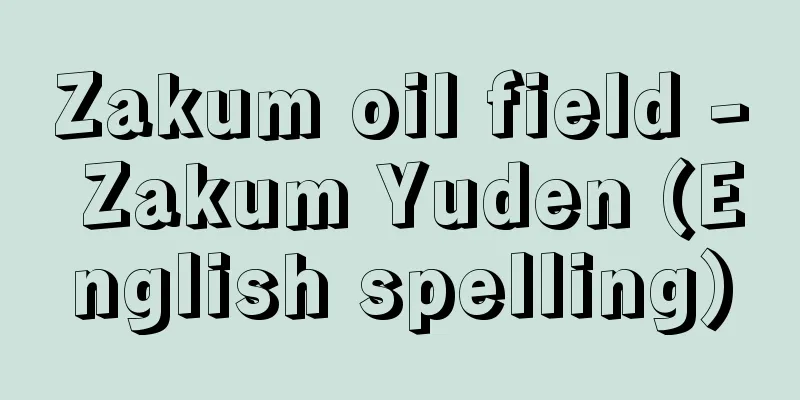Dosho - Dosho

|
Year of death: 10th March 4th of the Bunbu Era (3rd April 700) Year of birth: Jomei 1 (629) A representative monk of the 7th century. Also written as Dosho. The original source of his biography is the obituary in the Shoku Nihongi. Other sources include the 22nd chapter of the first volume of the Nihon Ryōiki and a fragment of the "Dōshō Hoshi Honganki" cited in the entry for December 16, 877, in the Nihon Sandai Jitsuroku. He was born in Tanbi District, Kawachi Province (Osaka Prefecture), and his common surname was Funatsuraji. The Funatsura clan were naturalized people of Baekje descent. His father was Eshaku. In 653, he traveled to China as a scholar on a Japanese envoy ship. He became a disciple of Xuanzang in Chang'an. This can be confirmed in Chinese historical documents, such as the Songshi Nihonden and Butsuzotoki. He studied the so-called Tripitaka of sutras, vinaya, and treatises (scriptures, precepts, and Buddhist studies) from Xuanzang, and also studied Zen, which he brought to Japan. Upon returning to Japan, Xuanzang bestowed him with the relics (the remains of Shakyamuni Buddha) and numerous sutras and treatises. In the 7th year of Saimei (661), he returned to Japan on a ship carrying Japanese envoys to the Tang Dynasty. He built a Zen temple in the southeast corner of Asuka's Hokko-ji Temple (Asukadera Temple, later Gangoji Temple) and lived there, spreading Zen and preaching various sutras. Some say that his teachings were Hosso, the same as those of Xuanzang's disciple, Qiji, but the more popular view is that he taught various teachings, including the Selon sect (a Chinese sect whose fundamental text is Asakusa's Sessho Mahayana-ron). On the other hand, he is said to have traveled around various places, dug wells by the roadside, set up boats at Jinji (crossings), and built bridges. However, the description in the Shoku Nihongi that he was responsible for the construction of the Uji Bridge is questionable. Was it Doto? After his death, he was cremated according to his will. This is said to be the beginning of cremation in Japan. There is some debate as to whether cremation took place before him, but this may be the first example of a central figure of influence. He also appears to have passed on the belief that bones are sacred, and there are stories of his remains bringing about miraculous fortunes. (Kazuhiko Yoshida) MichiakiYear of birth: 1281 (4th year of Koan) A monk from the Northern and Southern Courts period, known as the guardian monk of the emperor. Said to be the son of Ichijo Ietsune. He studied under Gyosho, and in 1336 he was the first to be appointed as a junsannomiya in the Jimon sect, and the following year became the guardian monk of Emperor Komyo of the Northern Court. He often performed esoteric Buddhist rituals for the imperial family. He later served as the abbot of Onjo-ji Temple. He also became an inspector of the Kumano Sanzan and Shin-Kumano. His books include the two-volume Taimitsukeigusho Sammai-ryu. (Masaki Akira) Source: Asahi Japanese Historical Biography: Asahi Shimbun Publications Inc. About Asahi Japanese Historical Biography |
|
没年:文武4.3.10(700.4.3) 生年:舒明1(629) 7世紀の代表的な僧。道照とも記す。『続日本紀』の死亡記事の伝が根本の史料。他に『日本霊異記』上巻第22話,『日本三代実録』元慶1(877)年12月16日条所引の「道照法師本願記」逸文もある。河内国(大阪府)丹比郡 の出身で,俗姓は船連氏。船氏は百済系の帰化人。父は恵尺。白雉4(653)年に遣唐使の船に乗って学問僧として入唐。長安の玄奘の弟子となった。このことは中国側の史料からも確認でき,『宋史日本伝』『仏祖統紀』にみえる。玄奘からは経・律・論(経典・戒律・仏教学)のいわゆる三蔵を広く学び,また禅を学習して日本に伝えた。帰国に際し,玄奘は彼に仏舎利(釈迦の遺骨)と多数の経論を授けた。斉明7(661)年,遣唐使の帰国船にて帰国。飛鳥の法興寺(飛鳥寺,のちの元興寺)の東南の隅に禅院を建てて住み,禅を広め,諸々の経典を説いた。その教学は,玄奘の高弟である窺基と同質の法相宗であるとする見方もあるが,摂論宗(無著の『摂大乗論』を根本典籍とする中国の一宗派)をはじめとしてさまざまな教学を伝えたとする見方が有力。その一方,各地を周遊して路傍に井戸を掘り,津済(渡)に船を設置したり,橋を造ったりしたという。ただし,宇治橋造立を彼によるとする『続日本紀』の記述は疑問。道登によるか。死亡後は遺命により火葬。わが国の火葬の始まりという。彼以前の火葬の有無については議論があるが,中央の有力者としては初例としてよい。骨を神聖視する信仰も伝えたらしく,彼の遺骨が奇瑞を示したというエピソードも残した。 (吉田一彦) 道昭生年:弘安4(1281) 南北朝期の僧で,天皇の護持僧として知られる。一条家経の子と伝わる。行昭に学び,建武3(1336)年寺門派で初めて准三宮に任じられ,翌年北朝の 光明天皇の護持僧となる。皇室のためしばしば密教の修法を行う。のち園城寺長吏を勤めた。また熊野三山,新熊野の検校にもなる。著書に『胎密契愚鈔三昧流』2巻などがある。 (正木晃) 出典 朝日日本歴史人物事典:(株)朝日新聞出版朝日日本歴史人物事典について 情報 |
<<: Daoqing - Daojyou (English spelling)
Recommend
Injisho-o - Hermit
...A collection of tales from the Northern and So...
space opera
…H. Gernsback, known as the father of American sc...
foremilk
…At the start of each feeding, milk with a low pH...
Remaining mountain water - Zanzanjosui
〘 noun 〙① Landscapes left after the ravages of war...
Kisan Castle
…Dayuan first became known in China through a rep...
draisienne
…However, it has been discovered that Sibrac is a...
Arius maculatus
A marine fish of the order Siluriformes and family...
Yusuke Hagiwara
Astronomer. Pioneer of celestial mechanics in Jap...
Ileum
〘Noun〙① A part of the small intestine that continu...
Flemish School - Flemish School
A school of music that flourished from the late 15...
Brown rot disease
...To prevent the disease, remove the scale insec...
Niyodo [village] - Niyodo
A village in Takaoka County, in the mid-west of Ko...
Acanthopanax sieboldianus Makino
A deciduous shrub of the Araliaceae family thought...
Income security - income security
The most important part of social security is to p...
Eriban - Eriban
…One of the leading industrial, cultural and acad...








![Menelik [II] - Menelik](/upload/images/67cd008e6cc35.webp)
